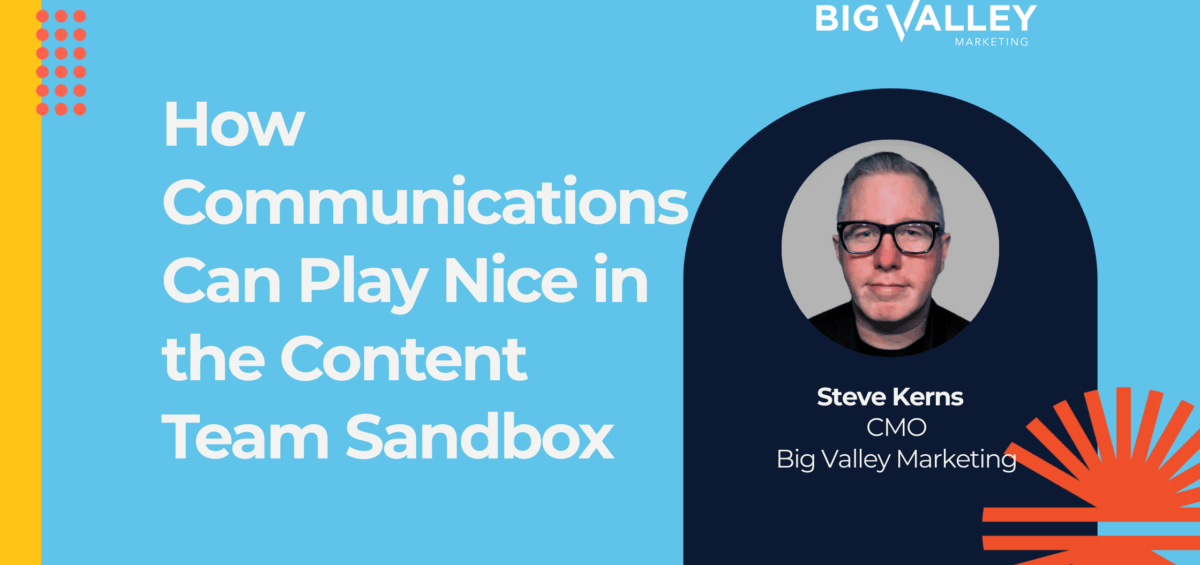By Steve Kerns
Communications teams face increasing challenges to securing media coverage for their news, brand and reputation efforts, and executive thought leadership perspectives. While building better stories and adjusting expectations can be effective ways for them to demonstrate their ongoing value and impact to their CMOs, could forging new types of relationships with other marketing disciplines provide a path toward expanding how the CMO thinks about communications team success?
For many organizations that Big Valley encounters, communications teams work in a silo and have lower levels of influence on other aspects of the wider marketing mix. In many cases this makes sense: a product-focused content marketing team aiming to inform a narrow audience about how to fix bugs and trying to build a community of power users could be distracted by a communications team request to amplify messages designed a highlight an executive’s thought leadership appearance at a tradeshow. In other cases: we think – and have observed – that there is opportunity for reimagining the original mission of certain marketing teams to transform them into channels that achieve their original goals AND create new ways for communications team messages to be expressed and deliver measurable value and impact for a brand.
While this is not an extensive or one-size-fits all list, following are several related insights the Big Valley team has generated from client communications teams that forged new relationships with marketing colleagues to leverage marketing channels to achieve communications goals:
A handful is more effective that a shot in the dark:
When all efforts to secure media coverage for an announcement fail, publishing the news to a company blog still delivers an opportunity to promote news to an audience. That said, this approach usually does not generate great results and is likely to be he an anomaly in the anatomy of the blog on which the news was posted. More effective approaches for using corporate blogs to promote communications messages start by aligning with the existing concept, cadence, style and historical effectiveness of the corporate blog. For example, blogs that use a campaign approach to deliver a collection of posts over time to create an audience and generate increasing traffic time can typically integrate a communications-themed campaigns. For example, rather than publishing one product announcement to a corporate blog on one day, a communications team could choose to publish a handful of posts related to the announcement across a month or a quarter: the initial announcement, a post that provides a deep dive on the technology, a post that gathers industry analyst commentary about the technology to better inform the blog’s audience about the technology, a Q&A style interview with the customer success team member that provides tips for how customers can use the product, and an update at a later date that profiles customer success with the new technology solution. In a scenario where a communications team is having a challenge creating immediate interest in a new product announcement, this type of approach can ensure that news is being delivered to a relevant audience on a consistent basis, generating audience engagement data via the corporate blog’s measurement function, creating a resource for ongoing media pitching about the product, and demonstrating to the CMO how the communications teams can evolve their relevance in the face of a shrinking media landscape.
Social is a safe place to experiment:
Two great reasons communications teams might consider prioritizing partnering with social media teams for delivering communications messages are the social media audience’s demand for a steady cadence of evolving content and social media’s ability to deliver instant data on audience engagement. The social media audience’s demand for a steady cadence of content reduces the comprehensive content requirements that communications-only approaches typical need. Communications teams could consider skipping the development of a full press release and instead develop a slide show specifically focused on a new product’s differentiation from competing products and a separate social card that that profiles a CEO quote about how the new product demonstrates the brand’s innovation capabilities. In this type of scenario and paired with effective engagement approaches, this type of content has the potential to produce immediate reactions from the audience to inform the communications team about the effectiveness of the message and provide closer to real time opportunities to adjust the communication to better deliver the intended message.
You attract more flies with honey than with vinegar:
Internal political theater, competing priorities, evolving needs, the pressure of meeting quarterly goals, lack of clarity, the existing To Do list of every individual and everyday life considerations are present in many marketing organizations and can create road bumps when communications teams attempt to leverage the tools of other marketing teams to promote their messages. The communications teams that most effectively create pathways for partnership with other marketing teams utilize approaches that are similar to how they might build a media or executive relationship. Considering the other person’s priorities, showing up with something that will be of value to both parties, embracing feedback, sticking to deadlines or being flexible to the other team’s timeline, and remaining collaborative create an environment for members of marketing teams to more easily embrace the integration of communications team objectives. In parallel, a communications team’s ability to highlight media wins and executive profile progress can be used to celebrate successful communications and marketing team collaborations and build goodwill across those teams. Everyone likes to be told they’ve done a good job and CMO’s appreciate seeing teams put their heads together to create new ways to drive traffic.











